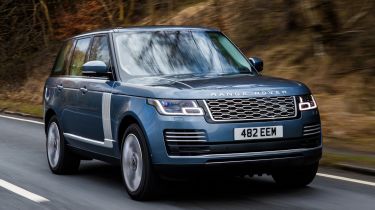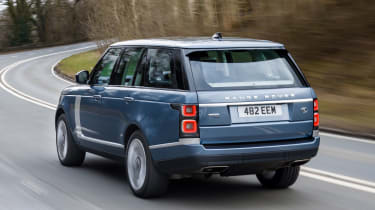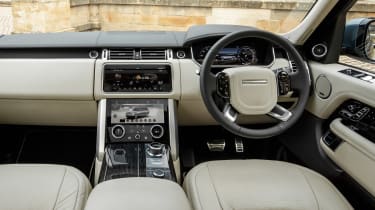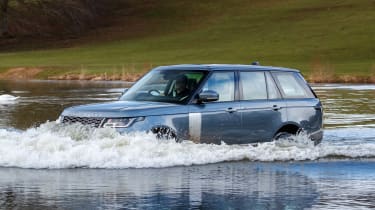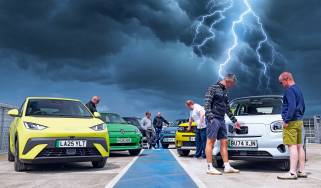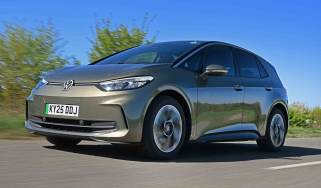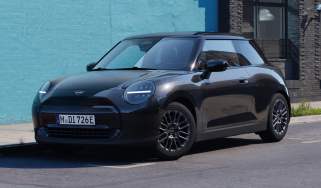New Range Rover PHEV 2018 review
There's now a plug-in hybrid version of the Range Rover. Badged P400e, it promises 31 miles of pure electric range and 101mpg

The new plug-in Range Rover P400e is a far more impressive car than the old diesel hybrid version. For the most part the engine and motor are well integrated, and the hushed drivetrain is in perfect step with the SUV’s character. But, just like most other PHEVs, the P400e is best in the city and on small, urban runs. On longer journeys the 2.0-litre petrol engine feels strained, harming fuel economy in the process.
The brief for the updated 2018 Range Rover was a simple one: Don’t change it, just improve it. And on paper, at least, Land Rover has done just that.
This new P400e version is the first ever plug-in hybrid Range Rover, mixing one of JLR’s new 296bhp Ingenium 2.0-litre four-cylinder petrol engines, along with the power from a 114bhp electric motor. This is fed by a 13.1 kWh battery pack under the boot floor, giving a pure electric range of 31 miles. Land Rover claims 101mpg combined and CO2 emissions of 64g/km, while charging from a 32amp wall box takes a little under three hours.
• Best hybrid SUVs on sale right now
Climb inside and the first thing you’ll notice is the overhauled dashboard. First seen in the Velar, Land Rover’s InControl Touch Pro Duo now appears in the Range Rover and uses two screens for a multitude of different information.
Like most plug-in hybrids there are different ways of driving the P400e. There are two drive modes: default Parallel Hybrid and pure EV. The latter puts the car into its electric only mode, while the former is slightly more complex.
Used - available now

2021 Land Rover
Range Rover
30,332 milesAutomaticPetrol2.0L
Cash £39,995
2017 Land Rover
Range Rover
76,100 milesAutomaticDiesel4.4L
Cash £23,995
2020 Land Rover
Range Rover
41,437 milesAutomaticDiesel3.0L
Cash £40,000
2021 Land Rover
Range Rover
46,647 milesAutomaticDiesel3.0L
Cash £41,750Leave the car to its own devices and the big Range Rover will switch between the petrol engine and electric motor, combining the two when necessary. There’s a ‘Save’ mode to hold onto the battery’s charge for use later on, or a Predictive Energy Optimisation (PEO) mode. Enter a destination into the sat-nav and the car will use GPS data to best use the engine and electric motor to maximise fuel economy.
Twist the rotary knob to ‘D’ and release the brakes, and the P400e glides away silently on electric power. At slow speeds the plug-in Range Rover is in its element with surprisingly quick responses and progressive brakes. It makes for quite an eerie sensation, with silence replacing the usual V6 or V8 roar. The tranquility is further enhanced with new thicker glass.
While driving around in EV mode is a joy, it won’t be long before the petrol engine kicks in. The engine and electric motor are very well integrated and the switch between combustion and battery power is almost seamless. But spot a gap in the traffic and there’s an alarming pause before the engine kicks in.
And while the engineers have done an excellent job in making the 2.0-litre four-cylinder engine blend into the background while cruising, under hard acceleration the four-cylinder unit sounds strained and coarse. Once the engine and motor are finally working together, however, the P400e is quick and quiet. In fact, it’s even faster than the V8 diesel.
Land Rover says the P400e will return 101mpg on the combined cycle, but in reality that figure is highly ambitious. Drive the car without plugging in and that figure will drop to around 25mpg, which is barely better than the V8 version. There’s no battery charge mode, either. Once you’ve depleted the 31-mile EV range, it’s not possible to use the petrol engine to charge up the batteries. It’s here where the 2.5-tonne SUV can feel a little out of its depth.
Elsewhere, all cars get a substantial styling overhaul. At the front there’s a new Velar style grille – which on the P400e contains a flap for the charging port – and revised bumper, while at the rear there are new lights and tailpipes.
Quality is improved inside, too, with new switchgear and that clearer dual-screen infotainment set-up. The seats are new, too – they’re wider and noticeably more supportive, making the Range Rover’s trademark commanding driving position even more comfortable.
There’s a new sunblind for the panoramic roof that opens and closes by waving your hand under the rear-view mirror, and there a number of new rear seat configurations and packs, too. Our car’s Executive Pack had airline-style individual seats with heated foot and calf rests, but the slow and wobbly electrically operated centre console is less inspiring.

